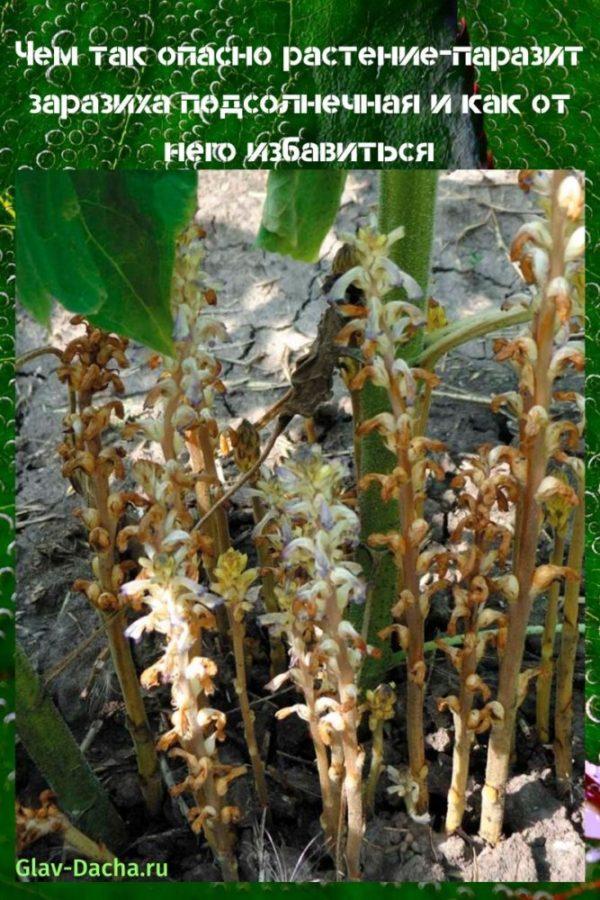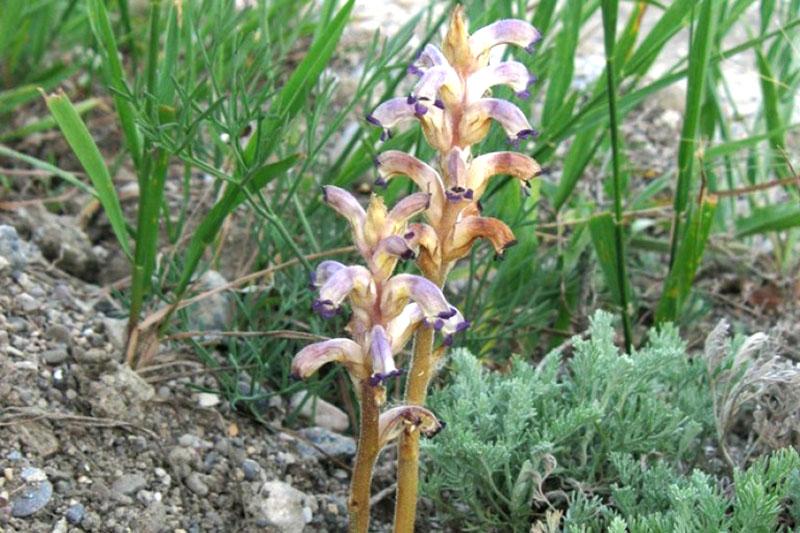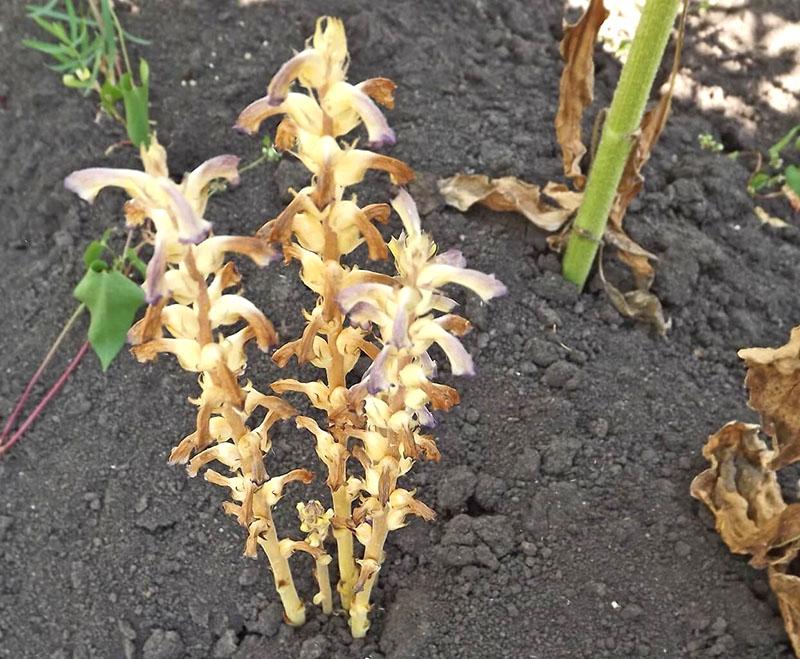Why is the plant-parasite sunflower broomrape so dangerous and how to get rid of it
 Sunflower broomstick is one of the most widespread highly specialized parasitic plants that infest sunflower and other crops of the Astrov family. It causes serious harm, as it infects the rhizomes of the host plant, drawing moisture and beneficial nutrients from it. The broomrape plant parasite is a problem faced by both homeowners and agricultural enterprises specializing in the cultivation of sunflowers.
Sunflower broomstick is one of the most widespread highly specialized parasitic plants that infest sunflower and other crops of the Astrov family. It causes serious harm, as it infects the rhizomes of the host plant, drawing moisture and beneficial nutrients from it. The broomrape plant parasite is a problem faced by both homeowners and agricultural enterprises specializing in the cultivation of sunflowers.
Sunflower broomstick: features and development cycle

Features of sunflower broomrape:
- straight white, yellowish or pinkish stems up to 45-60 cm high;
- branches are absent, stems are covered with scaly leaves;
- brown flowers, collected in inflorescence ears, are pollinated by flies and bumblebees;
- roots (haustoria) are short, fibrous and fleshy;
- fruits - polyspermous capsules containing up to 1500-2000 seeds.
 One plant gives at least 3-5 million seeds, which are easily carried by water, wind, stick to agricultural tools and human shoes. Broomrape seeds are distinguished by their extraordinary viability in the soil - up to 10-20 years, germinating under favorable conditions.
One plant gives at least 3-5 million seeds, which are easily carried by water, wind, stick to agricultural tools and human shoes. Broomrape seeds are distinguished by their extraordinary viability in the soil - up to 10-20 years, germinating under favorable conditions.
Broomrape harm
 Broomstick causes serious harm to plantings sunflower... The roots of the parasite attach to the root system of a cultivated plant, absorb water and vital nutrients, releasing toxic products of their vital activity into it.
Broomstick causes serious harm to plantings sunflower... The roots of the parasite attach to the root system of a cultivated plant, absorb water and vital nutrients, releasing toxic products of their vital activity into it.
Danger of sunflower broomrape:
- Due to their microscopic size, the seeds of the parasite spread quickly with machines, agricultural implements, wind and moisture.
- The seeds of the plant can remain in the soil for up to 20 years and germinate only when the sunflower roots appear nearby.
- The broomrape belongs to the highest facultative flowering cross-pollinated plants that tend to mutate quickly. The frequent emergence of new races significantly complicates the fight against the parasite.
 Measures to combat sunflower broomrape should be taken immediately after the first signs of infection appear, because its harmfulness is very high. With an average degree of damage, the yield of sunflower decreases by 30-60%, with the appearance of new, aggressive races, the decrease in yield can be 90-100%.
Measures to combat sunflower broomrape should be taken immediately after the first signs of infection appear, because its harmfulness is very high. With an average degree of damage, the yield of sunflower decreases by 30-60%, with the appearance of new, aggressive races, the decrease in yield can be 90-100%.
Sunflower infestation symptoms
 The main symptom of sunflower infection with broomrape is the appearance of whitish, pinkish or bluish stems at its base. A characteristic symptom of damage to the root system is a decrease in the fertility and yield of the crop.
The main symptom of sunflower infection with broomrape is the appearance of whitish, pinkish or bluish stems at its base. A characteristic symptom of damage to the root system is a decrease in the fertility and yield of the crop.
When removing the soil in the area of the base of the sunflower, you can find the roots of the broomrape, tightly attached to the host plant.
The broomstick feeds on water-mineral and organic substances contained in the roots of sunflower. This leads to its rapid drying and wilting, yellowing of the leaves and loss of elasticity, noticeable growth retardation.
The broomstick parasitizes not only on sunflower plantations.It also grows on tobacco, hemp, safflower, tomatoes and some weeds.
Broomrape control measures
There are several effective ways to get rid of a broomrape in a vegetable garden or agricultural fields. They consist of compliance with the rules of crop rotation, agrotechnical, biological and chemical control methods.
Compliance with the rules of crop rotation

Crop rotation - This is a periodic alternation of different crops sown on a plot or field. After the defeat of sunflower by broomrape for 9-10 years, it is necessary to plant crops that are resistant to this parasite. This time is necessary for the plant seeds remaining in the soil to become unviable.
Agrotechnical methods
 Agrotechnical methods of combating sunflower broomrape are considered effective with an average parasite infestation.
Agrotechnical methods of combating sunflower broomrape are considered effective with an average parasite infestation.
These include:
- deep plowing of the soil to a depth of 28-30 cm;
- regular weeding of weeds, carried out until the seeds ripen, after which the plant residues are collected and burned;
- abundant soil moisture - broomrape "prefers" dry soil.
An effective agronomic method of combating broomrape is a special stimulation of the germination of the maximum number of seeds from the soil by means of dense sowing of sunflower in the infected area.
Biological methods
 For the destruction of sunflower broomrape and plant protection, biological methods are used. One of them is the use of phytomize flies. The larvae of this insect feed on the seeds of the parasite plant, reducing their number in fertile soil.
For the destruction of sunflower broomrape and plant protection, biological methods are used. One of them is the use of phytomize flies. The larvae of this insect feed on the seeds of the parasite plant, reducing their number in fertile soil.
Also, many farmers use bioherbicides - special biological preparations designed to destroy broomrape and other parasites. But most often this method is inferior in efficiency to treatment with chemical herbicides.
Chemical methods of struggle
 The fight against sunflower broomrape is often carried out with the help of herbicides of the imidazoline group, which cause weakening, disease and subsequent death of the parasite plant. The most popular herbicides are Device Ultra and Euro Lightning.
The fight against sunflower broomrape is often carried out with the help of herbicides of the imidazoline group, which cause weakening, disease and subsequent death of the parasite plant. The most popular herbicides are Device Ultra and Euro Lightning.
Device Ultra is a herbicide from the group of imidazolines, produced in the form of a water-soluble concentrate. The main active ingredients are imazamox and imazapir. These components penetrate through foliage and stems to the root of the weed plant, causing its death.
Broomrape-resistant hybrids
 The most effective way to prevent sunflower infection with broomrape is to use hybrids that are highly resistant to the parasite. The only drawback of this method is that broomrape-resistant sunflower seeds are expensive compared to conventional seed.
The most effective way to prevent sunflower infection with broomrape is to use hybrids that are highly resistant to the parasite. The only drawback of this method is that broomrape-resistant sunflower seeds are expensive compared to conventional seed.
Sunflower hybrids resistant to broomrape:
- Forward - is distinguished by high immunity to broomrape, powdery mildew, stem and basket rot, phomosis;
- Jason - the main feature of the hybrid is the ability to resist many parasites and weeds at the genetic level;
- Tunka - characterized by high resistance to many weeds, unfavorable weather conditions and good yield;
- Pioneer is a versatile hybrid that gives a high yield in almost any growing conditions;
- Syngenta is a hybrid with a strong immune system and good yields.
The appearance of sunflower broomrape in the field or in the garden is a common and serious problem that requires urgent action. The parasite plant feeds on sunflower juices, inhibiting its growth and causing death. Effective ways to combat broomrape, the use of powerful chemical herbicides and hybrids with genetic resistance to progressive races will help get rid of the parasite and save crops.